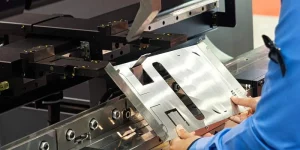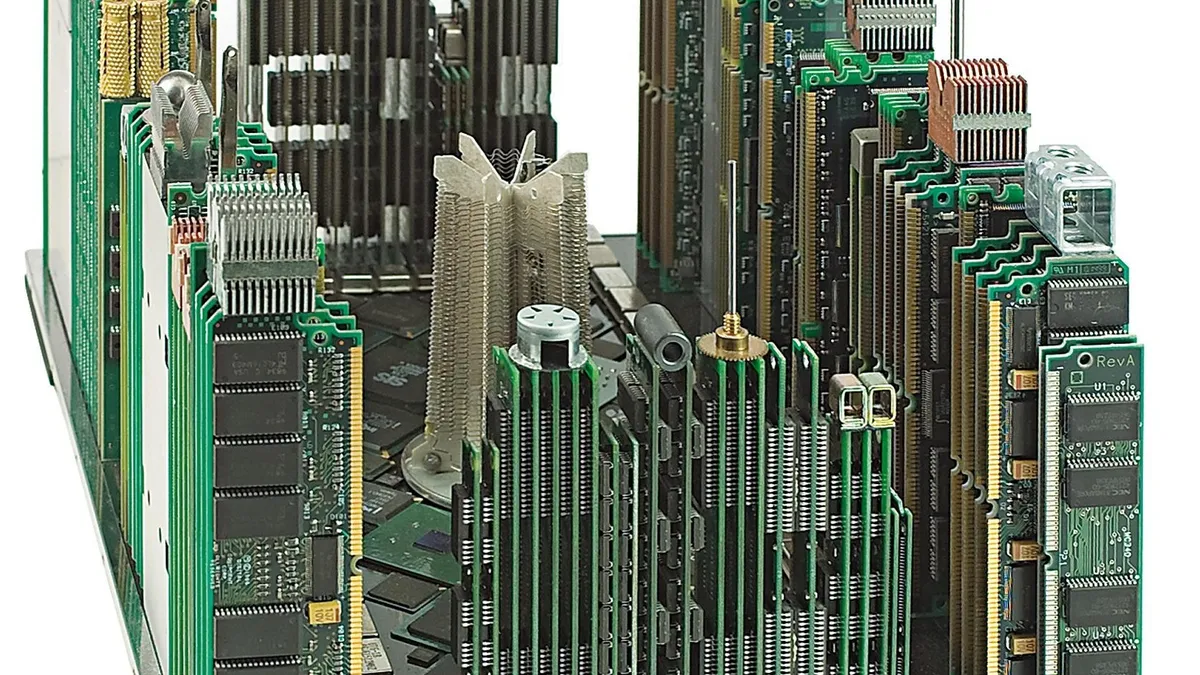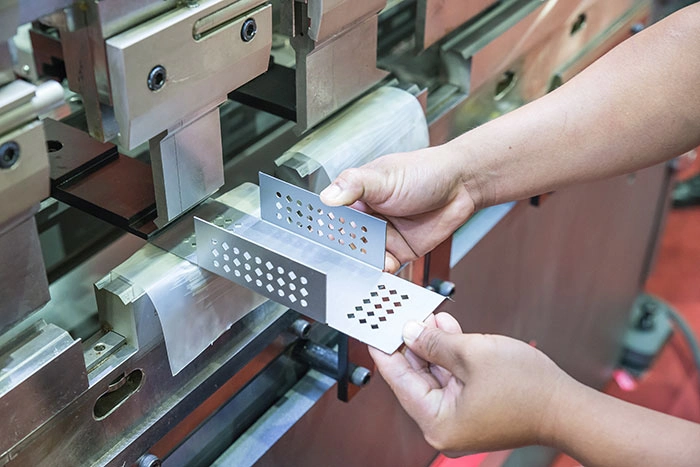Plate metal manufacturing involves precise slicing, bending, and assembling thin metal sheets. Challenges include waste management and achieving ideal bending angles. Cutting-edge technology like automation and 3D printing revolutionize processes for efficiency. Tools like laser cutting machines and CNC punching provide accuracy. Automation reduces manual labor, increases productivity, and improves precision. Integrating robotics and AI boosts productivity. Advanced forming techniques like hydroforming achieve complex shapes accurately. Quality control measures and sustainability practices guarantee high standards. Future trends focus on AI integration and sustainability. Master plate metal manufacturing challenges with cutting-edge technology for best results. Here is sheet metal fabrication guide, covering everything from materials and tools to techniques and safety precautions:
Key Takeaways
- Automation systems streamline processes for precision and efficiency.
- Advanced tools like laser cutting machines enhance accuracy and speed.
- Innovative software allows for accurate simulations and modeling.
- Robotics and AI-driven predictive maintenance improve productivity.
- Integration of technology minimizes errors and optimizes resource utilization.
Understanding Sheet Metal Fabrication
Exploring the realm of plate metal crafting uncovers a detailed procedure involving shaping and manipulating thin metal plates into various structures and components. This process incorporates precise cutting, bending, and assembling techniques to achieve the desired results. Understanding the intricacies of plate metal crafting is essential for those seeking to master the art of working with metal sheets effectively.
Common Challenges Faced
Exploring through the intricate realm of sheet metal fabrication often presents fabricators with a variety of typical challenges that demand innovative solutions for successful outcomes. Common challenges include material waste management, precision cutting difficulties, and achieving ideal bending angles. These obstacles require careful planning, advanced machinery, and skilled labor to make certain the fabrication process reaches high standards of quality and efficiency.
Importance of Innovative Technology
In today’s highly competitive sheet metal fabrication industry, the importance of groundbreaking technology cannot be overstated. Technology advancements have revolutionized fabrication processes, leading to improved production efficiency and superior product quality. State-of-the-art fabrication tools have become vital for staying ahead in the market and meeting the demands of modern manufacturing standards.
Technology Advancements in Fabrication
With the constantly changing scene of manufacturing, the integration of state-of-the-art technology plays an essential role in revolutionizing the field of fabrication.
- Automation systems improve precision and efficiency.
- 3D printing allows for intricate designs and rapid prototyping.
- Advanced software empowers accurate simulations and modeling.
Enhancing Production Efficiency
To optimize production efficiency in sheet metal fabrication, the strategic implementation of cutting-edge technology is imperative. Advanced technologies such as automated robotic systems, real-time monitoring software, and AI-driven predictive maintenance tools play a vital role in streamlining processes, reducing downtime, and enhancing overall productivity. By investing in these state-of-the-art solutions, manufacturers can achieve higher output levels while maintaining superior quality standards.
Cutting-Edge Fabrication Tools
Utilizing cutting-edge fabrication tools transforms the sheet metal manufacturing process, enhancing efficiency and precision to unmatched levels.
- Laser cutting machines offer high accuracy and speed.
- CNC punching machines provide versatile and precise punching capabilities.
- Waterjet cutting technology allows for the precise cutting of a wide range of materials.
Enhancing Efficiency With Automation
Automating workflows in sheet metal fabrication processes can significantly improve efficiency by reducing manual labor and human error. This automation not only streamlines production but also leads to a increase in productivity levels. By incorporating automated systems, manufacturers can optimize their operations and achieve higher output rates with improved precision.
Automated Workflow Streamlining
Incorporating automated workflow streamlining can significantly boost operational efficiency in sheet metal fabrication processes.
- Automated material handling reduces manual labor and speeds up production.
- Integration of robotics minimizes errors and improves precision in cutting and forming.
- Software automation for scheduling and tracking improves overall workflow management.
Productivity Boost Through Automation
Improving operational efficiency in sheet metal fabrication processes can be achieved through the implementation of advanced automation technologies. Automated systems can handle repetitive tasks with precision and speed, reducing the dependence on manual labor. By integrating robotics, artificial intelligence, and machine learning, productivity can be greatly boosted while maintaining high-quality standards. Automation streamlines production lines, minimizes errors, and optimizes resource utilization, leading to improved overall efficiency.
Precision in Sheet Metal Cutting
Attaining best accuracy in sheet metal cutting is crucial for ensuring the correctness and quality of fabricated metal components.
- Use of advanced laser cutting technology
- High precision CNC machining
- Implementing computer-aided design (CAD) for precise cutting paths
Advanced Forming Techniques
Utilizing cutting-edge technologies and specialized equipment, sheet metal fabrication industries are constantly evolving to incorporate advanced forming techniques for improved precision and efficiency. These techniques include hydroforming, electromagnetic forming, and incremental sheet forming, allowing for complex shapes to be achieved with high accuracy and minimal material waste. By embracing these progressive methods, manufacturers can boost their production processes and deliver superior quality products to meet customer demands.
Quality Control Measures
Building on the foundation of advanced shaping techniques, sheet metal fabrication industries implement strict quality control measures to guarantee the precision and consistency of their produced components.
- Regular inspections and audits confirm adherence to quality standards
- Utilization of state-of-the-art measurement tools for accurate assessments
- Implementation of quality management systems to track and enhance product quality
Sustainability Practices in Fabrication
Incorporating sustainable practices into sheet metal fabrication processes is important for minimizing environmental impact and promoting long-term industry viability. Implementing energy-efficient equipment, recycling scrap metal, and reducing waste generation are key strategies. Utilizing eco-friendly coatings and implementing water conservation measures further boost sustainability efforts. By adopting these practices, sheet metal fabrication companies can reduce their carbon footprint and contribute to a greener future for the industry.

Future Trends in Sheet Metal Industry
The evolution of automation and digitalization is shaping the future of the sheet metal industry, revolutionizing traditional fabrication processes.
- Increased Integration of Artificial Intelligence and Machine Learning
- Adoption of Advanced Robotics for Complex Fabrication Tasks
- Emphasis on Sustainable and Eco-Friendly Practices
Frequently Asked Questions
How Can Digital Technology Improve the Efficiency of Sheet Metal Fabrication Processes?
Digital technology improves sheet metal fabrication processes by optimizing design through CAD software, streamlining production via automation, and improving precision with CNC machinery. Real-time monitoring and data analytics further boost efficiency, reducing errors and increasing productivity.
What Are Some Common Quality Control Measures Implemented in Sheet Metal Fabrication?
Quality control measures in sheet metal fabrication include dimensional inspections, material testing, weld inspections, and surface finish checks. Advanced technologies like laser scanning, coordinate measuring machines, and automated vision systems are commonly used to guarantee accuracy and consistency in the final products.
How Can Sustainability Practices Be Integrated Into Sheet Metal Fabrication Processes?
Sustainability practices can be integrated into sheet metal fabrication by optimizing material usage, implementing energy-efficient processes, and recycling scrap metal. Utilizing eco-friendly coatings and exploring renewable energy sources further improve environmental responsibility in fabrication operations.
What Are Some Advanced Forming Techniques That Are Currently Being Used in the Sheet Metal Industry?
Advanced shaping techniques in the sheet metal industry include hydroforming, electromagnetic forming, and incremental sheet forming. These methods offer precision, efficiency, and versatility in crafting intricate geometries with improved material properties, contributing to the industry’s evolution.
What Are Some Upcoming Trends and Innovations to Look Out for in the Sheet Metal Industry?
Some upcoming trends in the sheet metal industry include the integration of IoT for real-time monitoring, AI-driven automation for improved efficiency, and advancements in laser cutting technology for accuracy. These innovations promise to revolutionize sheet metal fabrication processes.
Conclusion
In summary, the integration of cutting-edge technology in sheet metal fabrication is essential for overcoming challenges and achieving high levels of efficiency and precision. By embracing automation, advanced forming techniques, quality control measures, and sustainability practices, industry professionals can navigate complexities with finesse. The evolution of the sheet metal industry towards improved productivity and excellence in craftsmanship is propelled by a strategic blend of expertise and technological innovation, setting new standards for quality and precision.
You May Also Like:






